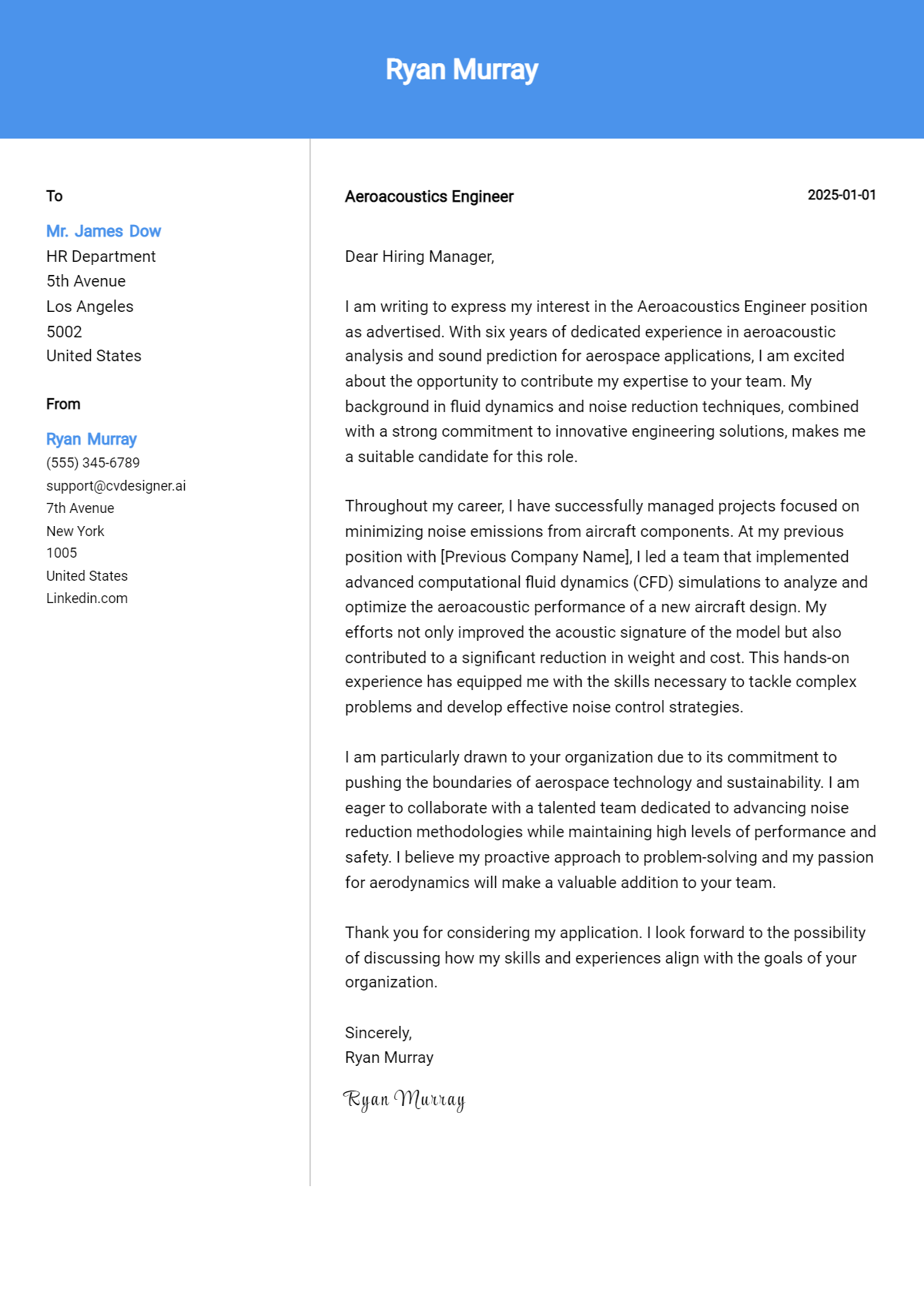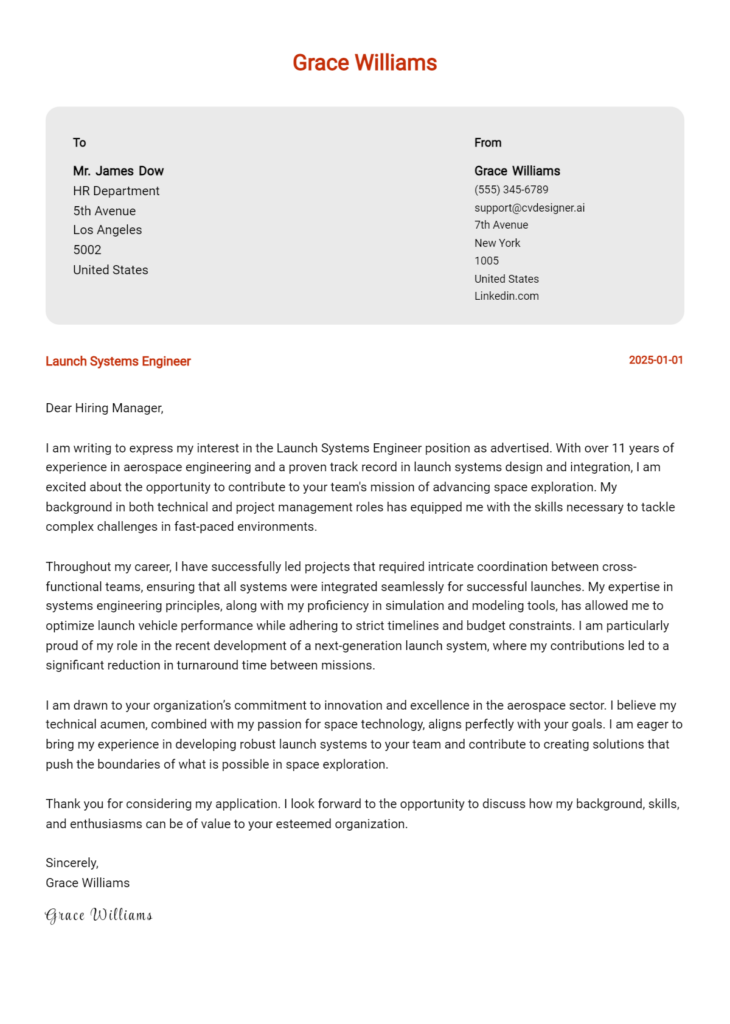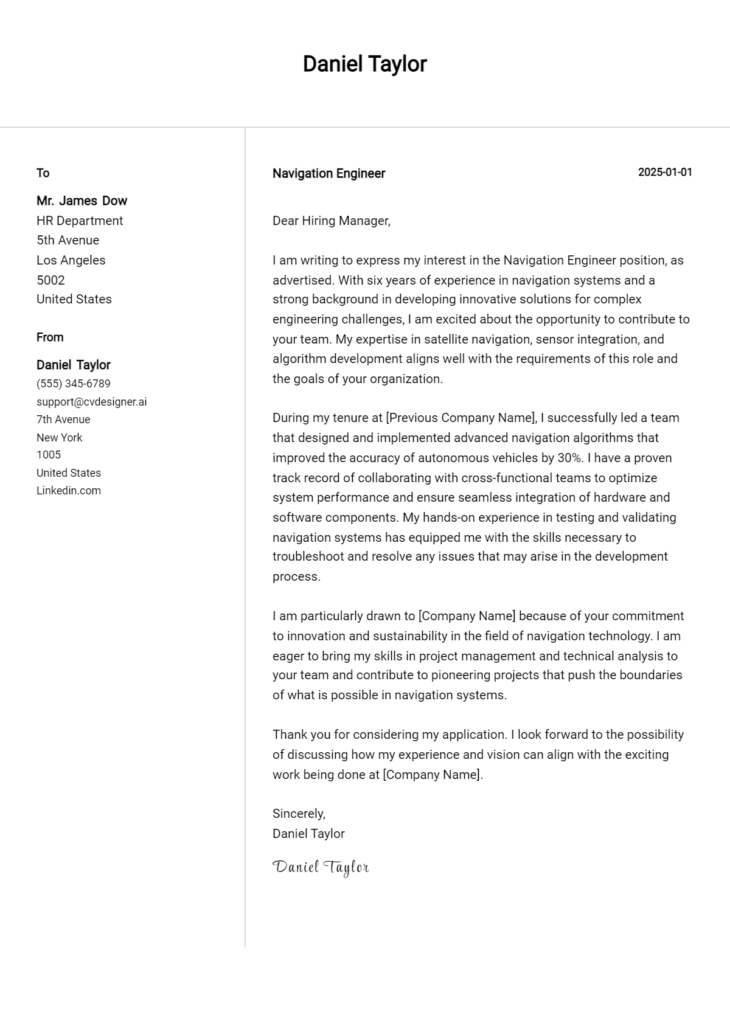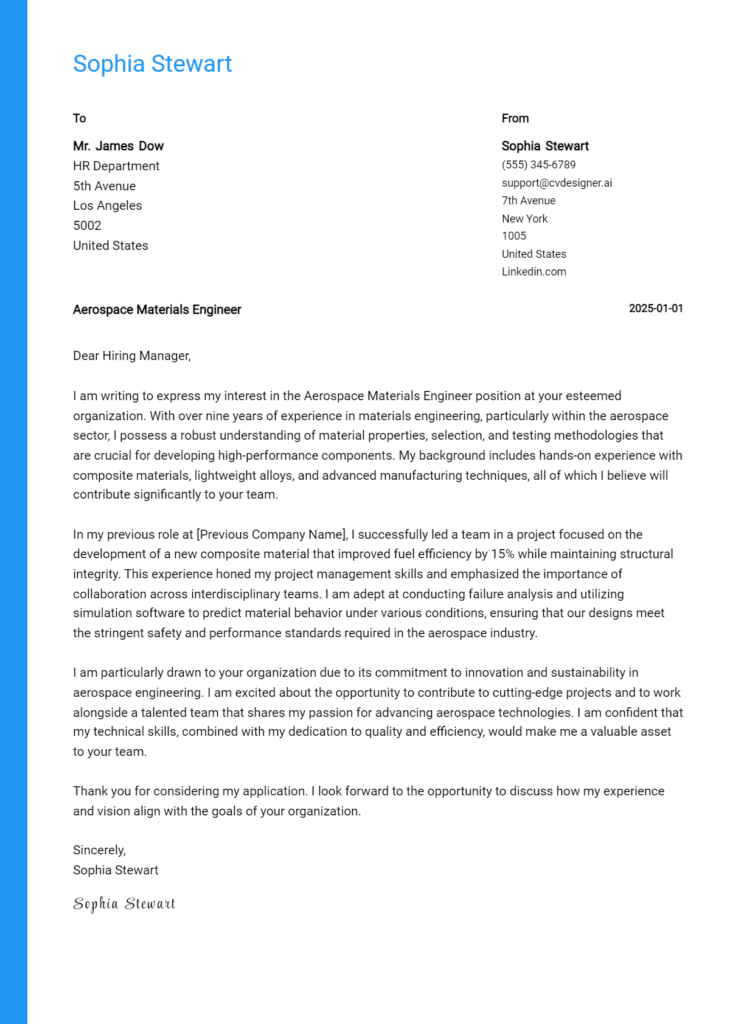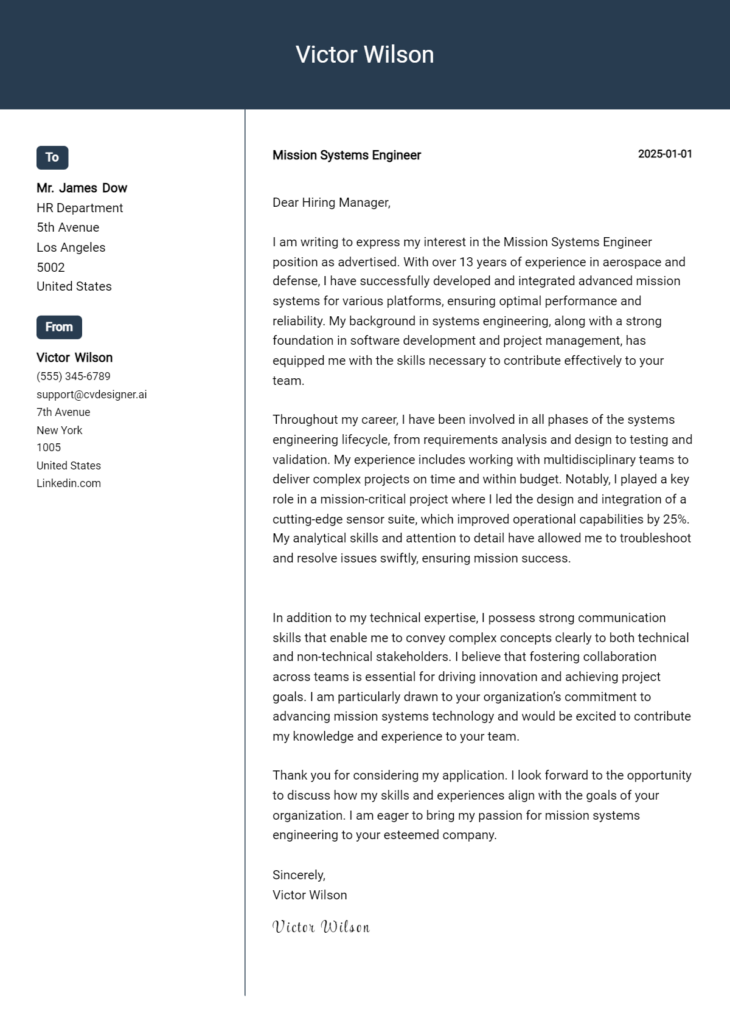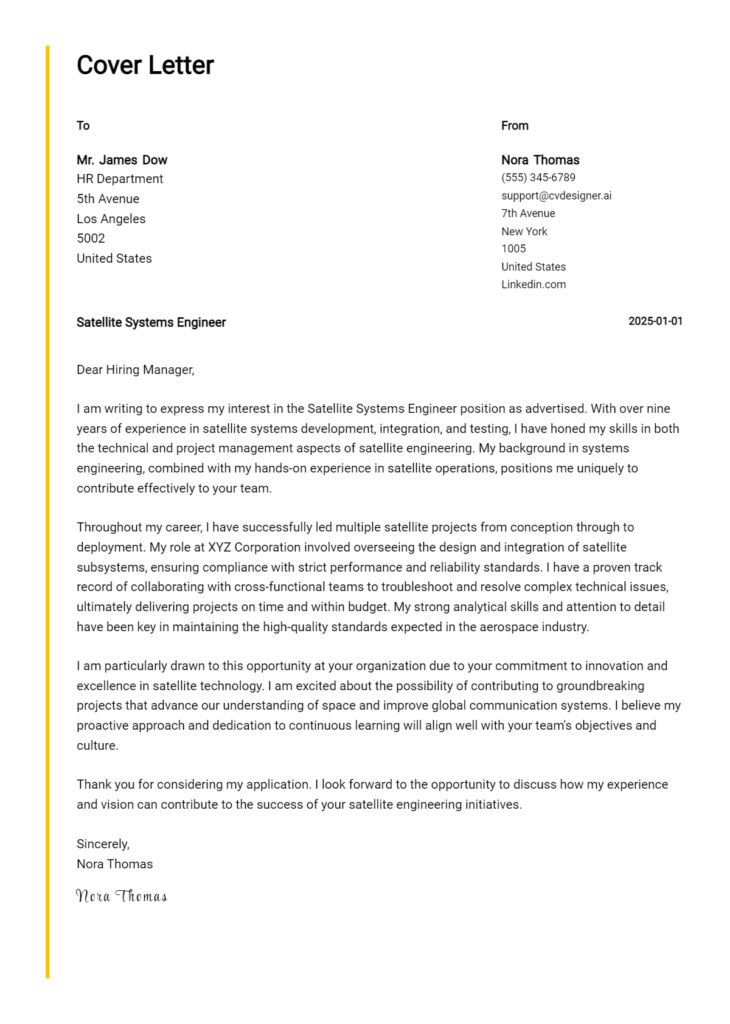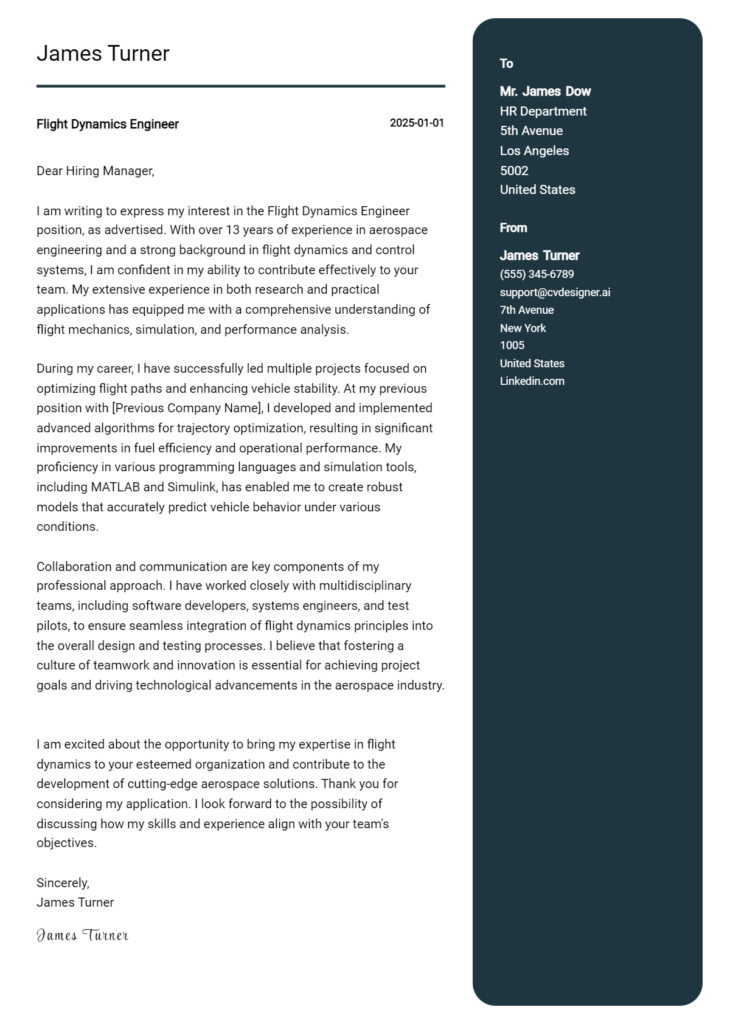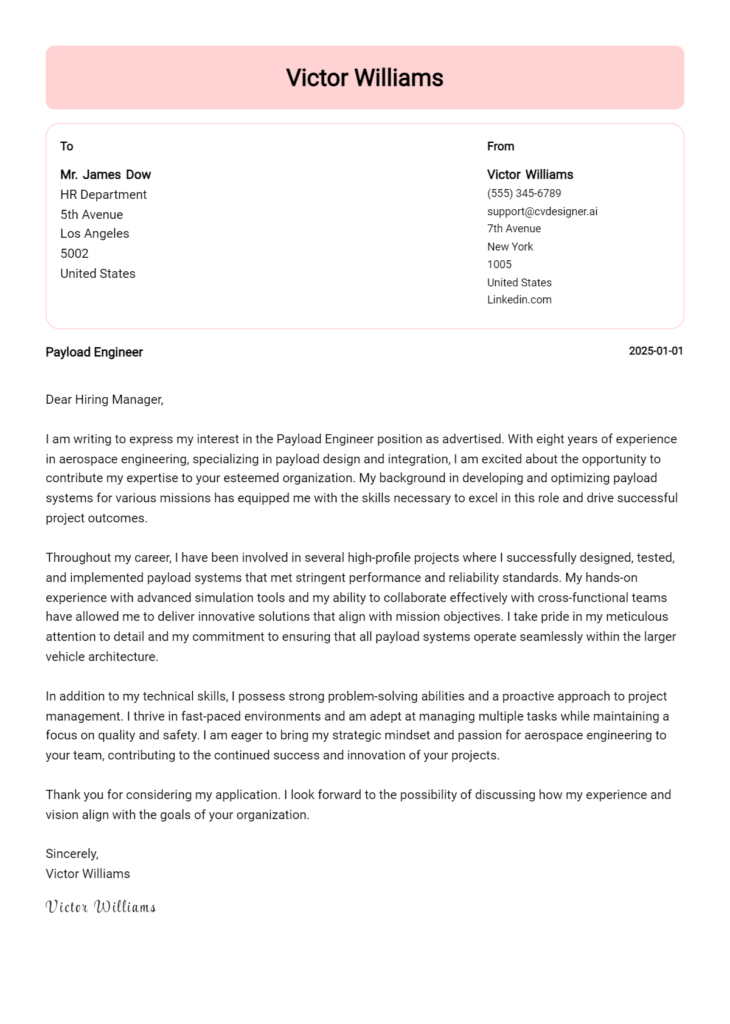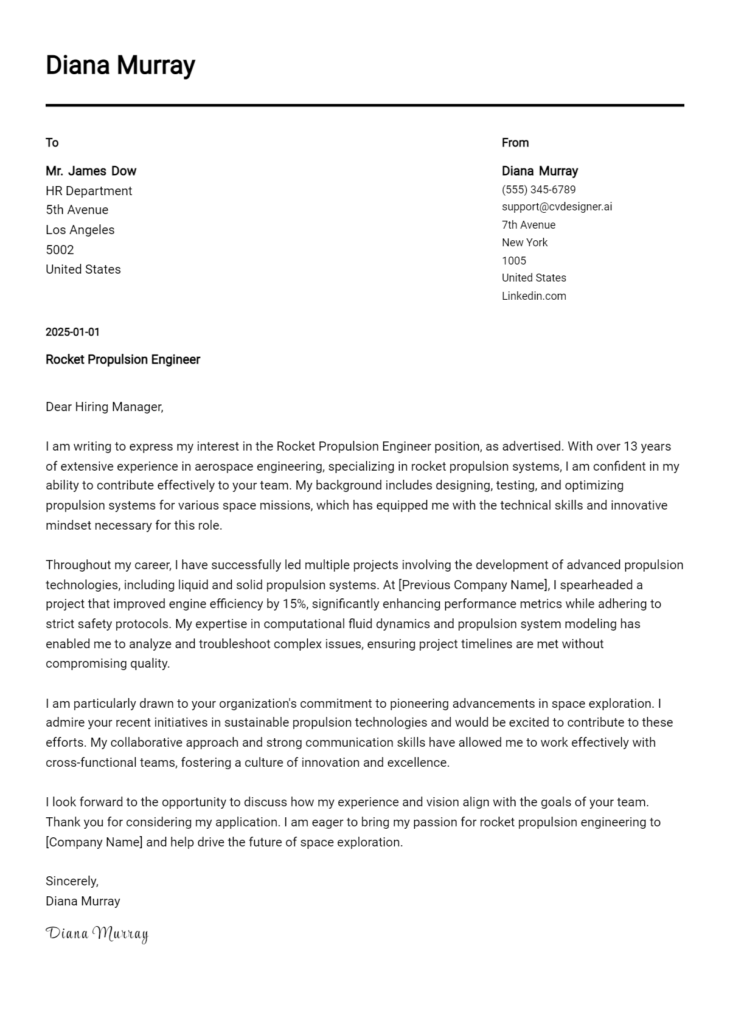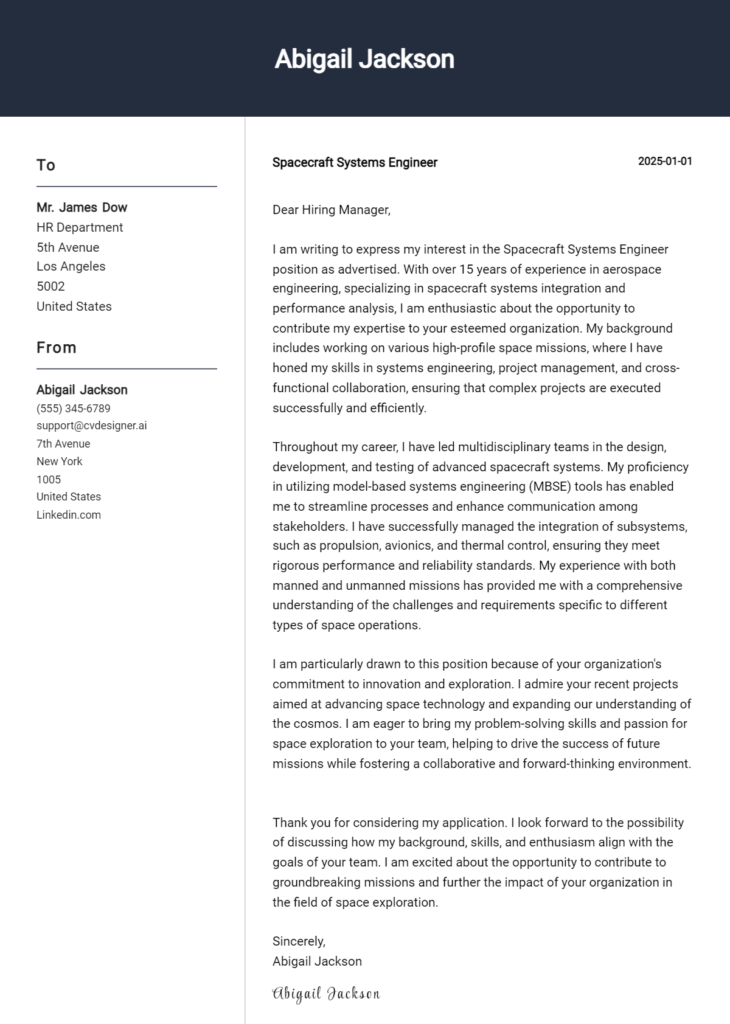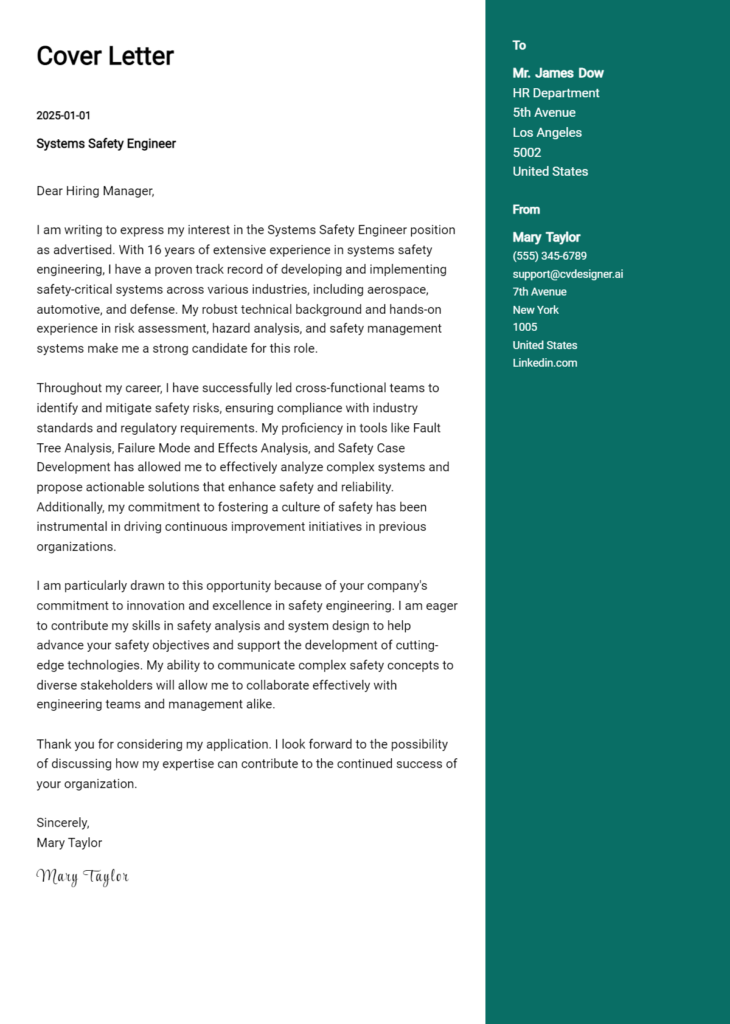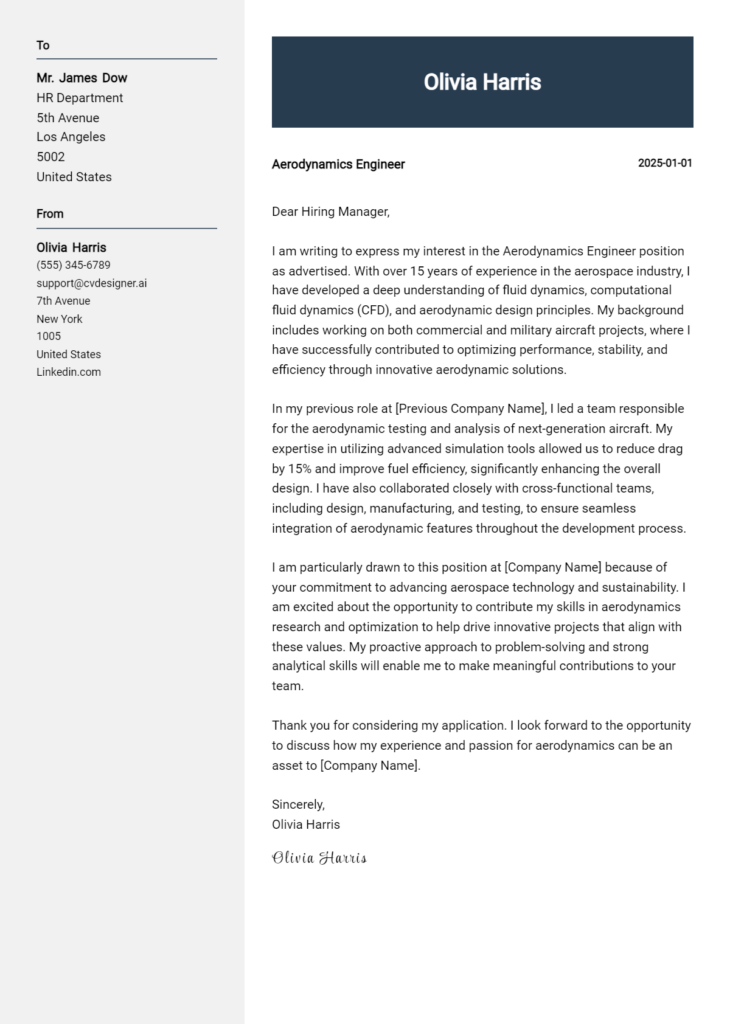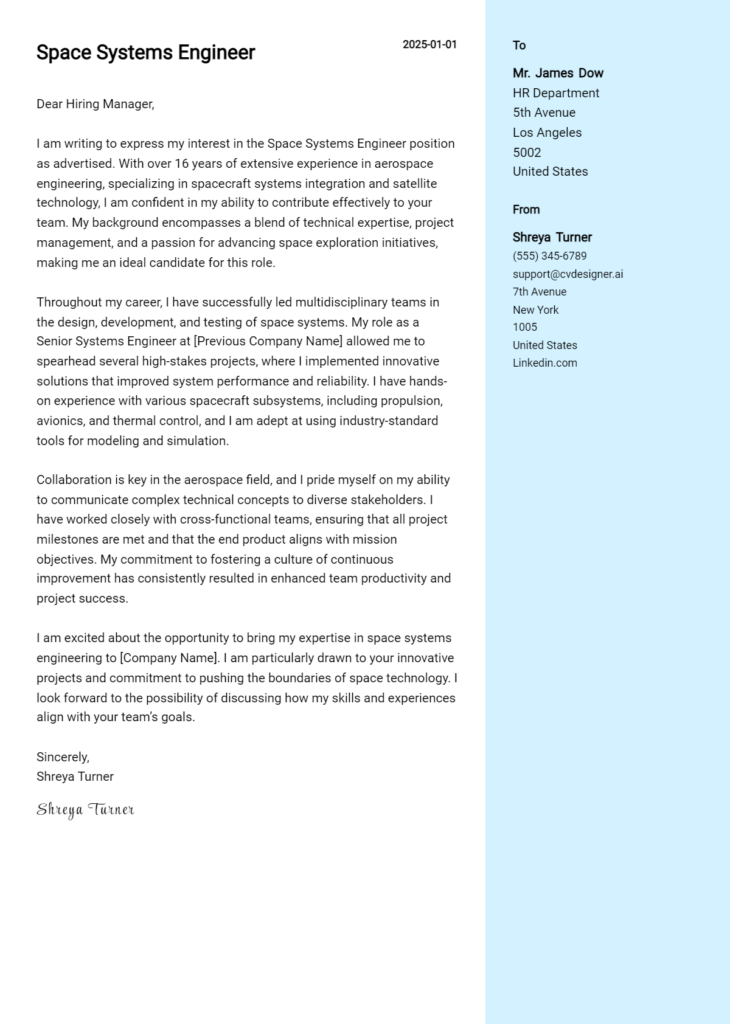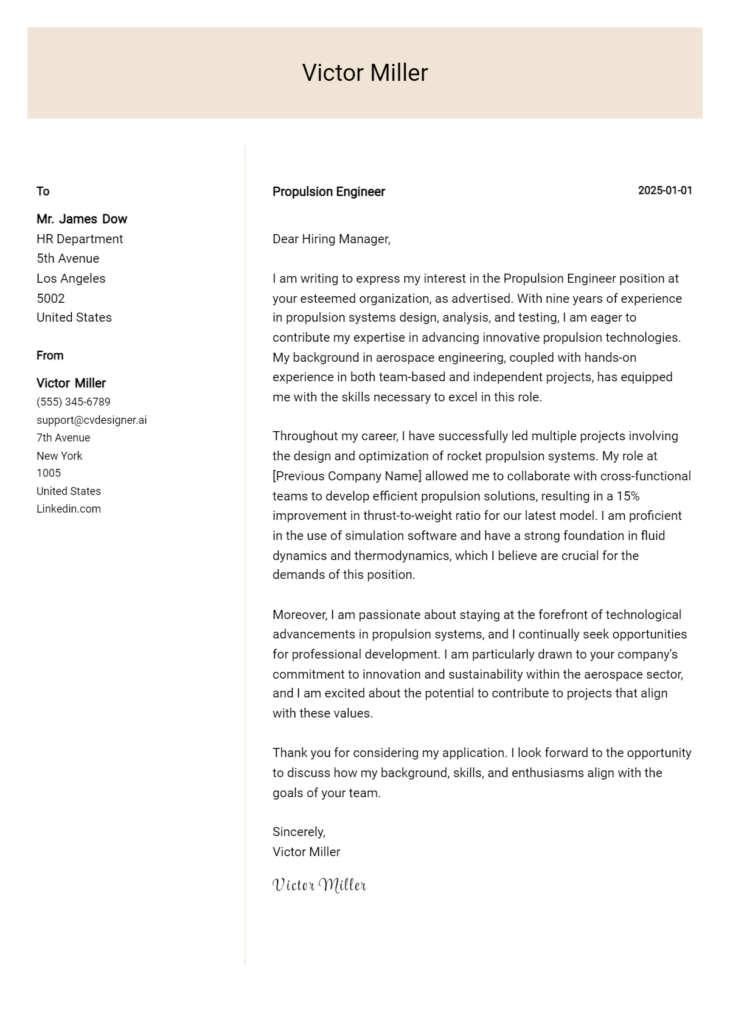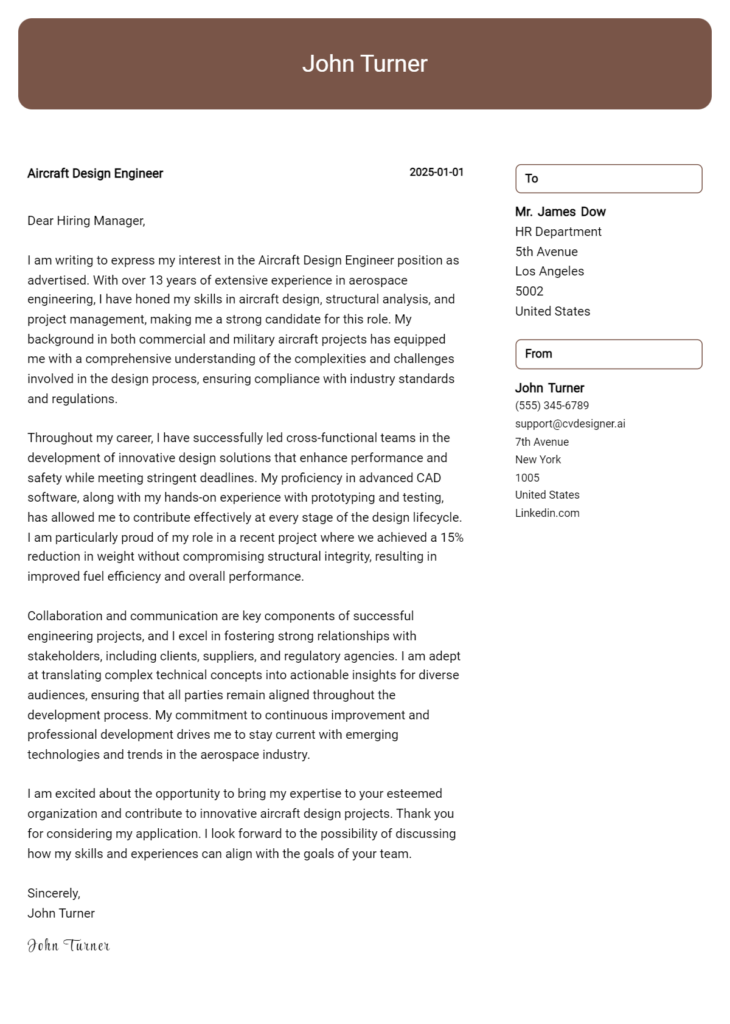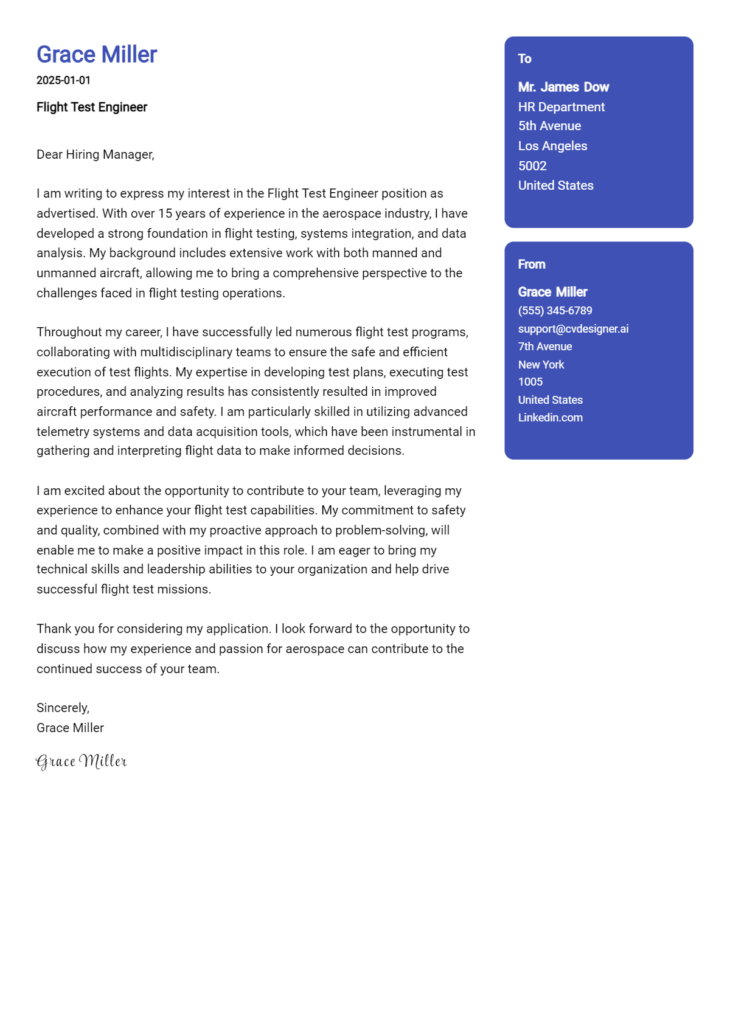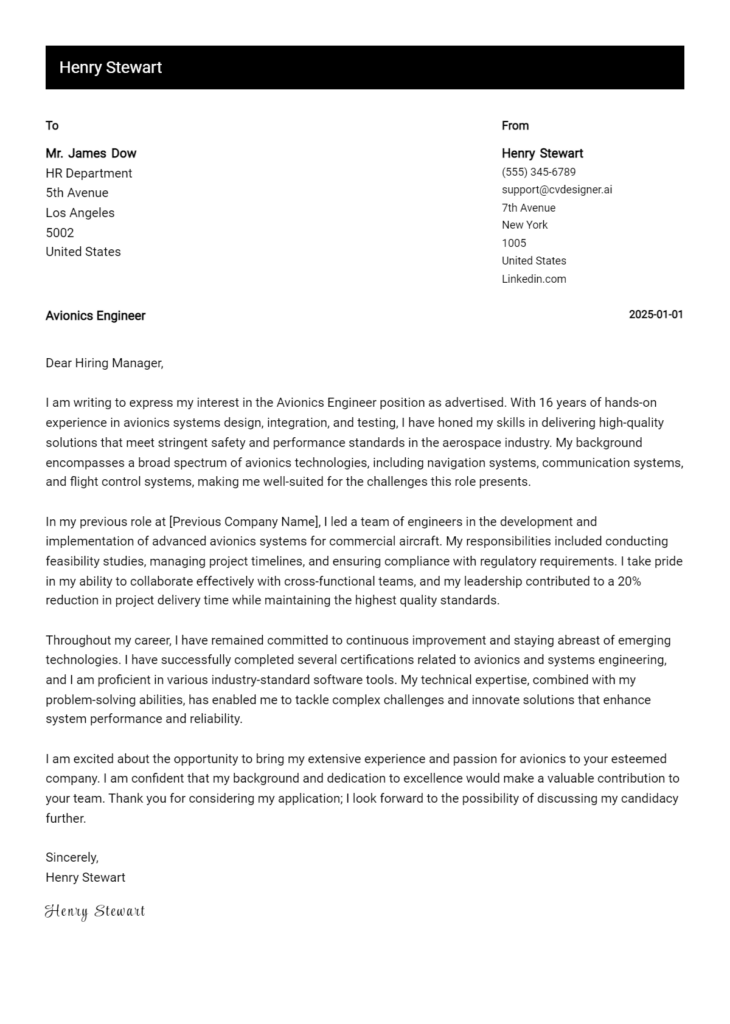Aeroacoustics Engineer Cover Letter Examples
Explore additional Aeroacoustics Engineer cover letter samples and guides and see what works for your level of experience or role.
How to Format an Aeroacoustics Engineer Cover Letter
Crafting a compelling cover letter is essential for an Aeroacoustics Engineer, as it not only showcases your technical expertise but also demonstrates your ability to communicate complex concepts clearly. The format of your cover letter is crucial; it reflects your attention to detail and your understanding of the aerodynamic principles that govern sound behavior in aerospace applications. A well-structured cover letter can capture the hiring manager's attention and convey your passion for the field, setting you apart from other candidates.
In this guide, we'll outline how to structure your cover letter, offering insights and specific examples tailored for Aeroacoustics Engineers to help you create a persuasive document.
We'll focus on the essential components of a professional cover letter, including:
- Cover Letter Header
- Cover Letter Greeting
- Cover Letter Introduction
- Cover Letter Body
- Cover Letter Closing
Each section plays a vital role in emphasizing your qualifications and professionalism. Let’s break down each part and explain how to make your Aeroacoustics Engineer cover letter stand out.
Importance of the Cover Letter Header for an Aeroacoustics Engineer
The cover letter header is a critical component of any professional application, particularly for specialized roles like an Aeroacoustics Engineer. It serves as the first impression and sets the tone for the rest of the letter. A well-structured header should include your contact information, the date, and the recipient's details. Clarity and professionalism are paramount, as they reflect your attention to detail and respect for the hiring manager's time. An effective header not only makes it easier for the recipient to contact you but also showcases your professionalism and organizational skills.
Strong Example
Jane Doe 1234 Soundwave Lane Aero City, AC 12345 (123) 456-7890 jane.doe@email.com October 1, 2023 Mr. John Smith Aeroacoustics Department Innovative Aerospace Solutions 5678 Jetstream Blvd Aero City, AC 67890
Weak Example
jane doe 10/1/2023 Mr. Smith Aerospace Co.
The Importance of a Cover Letter Greeting for an Aeroacoustics Engineer
The greeting of your cover letter serves as the first impression your potential employer will have of you, setting the tone for the rest of your application. A thoughtful and personalized greeting showcases your professionalism and attention to detail, while also demonstrating your interest in the position. Addressing the hiring manager by name can create a connection and convey that you’ve taken the time to research the company and its team. To avoid generic greetings, such as "To Whom It May Concern," consider looking up the name of the hiring manager or department head. If this information is not readily available, a more general yet respectful approach can still work, but it’s always better to strive for a personal touch.
Strong Greeting Example
Dear Dr. Emily Carter,
Weak Greeting Example
To Whom It May Concern,
The Importance of a Well-Crafted Cover Letter Introduction for an Aeroacoustics Engineer
A well-crafted cover letter introduction is crucial for an Aeroacoustics Engineer as it serves as the first impression to the hiring manager. This opening paragraph should not only captivate attention but also express genuine enthusiasm for the position. It is an opportunity to briefly highlight relevant skills, experiences, or achievements that align with the job requirements, setting the tone for the rest of the letter. A strong introduction can distinguish a candidate from the competition, while a weak one may result in their application being overlooked.
Strong Example
Dear [Hiring Manager's Name], I am excited to apply for the Aeroacoustics Engineer position at [Company Name], where my passion for noise reduction and my extensive experience in computational fluid dynamics can contribute to your mission of creating quieter and more efficient aircraft. With over five years of hands-on experience in developing innovative acoustic solutions, I successfully led a project that reduced jet noise emissions by 30%, demonstrating my commitment to advancing aerospace technology and environmental sustainability.
Weak Example
Dear [Hiring Manager's Name], I am writing to apply for the Aeroacoustics Engineer job at [Company Name]. I have some experience in engineering and think I would be a good fit for the role. I’m interested in working in aerospace and have worked on various engineering projects, but I’m not sure how my skills match your needs.
Purpose of the Cover Letter Body for an Aeroacoustics Engineer
The cover letter body for an Aeroacoustics Engineer serves as a crucial platform for candidates to effectively communicate their expertise and relevance to the prospective employer. It allows applicants to illustrate their technical skills, relevant experiences, and notable achievements in the field of aeroacoustics. By highlighting specific projects, such as successful noise reduction initiatives or contributions to innovative design solutions, candidates can demonstrate their capability to add value to the company. A well-crafted cover letter body can make a strong impression, showcasing not just familiarity with theoretical concepts but also practical applications and results that align with the company’s goals.
Strong Example
Dear Hiring Manager, I am excited to apply for the Aeroacoustics Engineer position at XYZ Aerospace. During my tenure at ABC Engineering, I led a team in reducing the noise levels of a new aircraft model by 15%, utilizing advanced simulation techniques and wind tunnel testing. Additionally, I developed a novel acoustic treatment that was implemented in our latest production line, resulting in a 30% decrease in environmental noise complaints. My experience with cross-functional teams and my in-depth knowledge of regulatory standards equip me to contribute effectively to your projects aimed at enhancing aircraft performance while ensuring compliance with noise regulations. Sincerely, [Your Name]
Weak Example
Dear Sir or Madam, I am writing to express my interest in the Aeroacoustics Engineer position. I have some experience in engineering and have worked on projects related to noise. I believe I can help your company. I am familiar with some software tools and have taken courses on noise reduction. I hope to bring my skills to your team. Best regards, [Your Name]
Importance of the Cover Letter Closing for an Aeroacoustics Engineer
The closing paragraph of your cover letter is crucial as it serves to summarize your qualifications and express your enthusiasm for the Aeroacoustics Engineer role. It provides an opportunity to reinforce your fit for the position while encouraging the hiring manager to take the next steps, such as reviewing your resume or scheduling an interview. A strong closing can leave a lasting impression, while a weak one might fail to convey your genuine interest or qualifications.
Strong Example
Thank you for considering my application for the Aeroacoustics Engineer position. With a solid background in fluid dynamics and extensive experience in noise reduction techniques, I am excited about the opportunity to contribute to your team at [Company Name]. I look forward to the possibility of discussing how my skills can help advance your projects and goals. Please feel free to contact me at your convenience to schedule an interview. I have attached my resume for your review, and I hope to hear from you soon.
Weak Example
Thanks for reading my letter. I think I’d be good at this job, and I hope you look at my resume. Let me know if you want to talk.
Crafting an effective cover letter is essential for aspiring Aeroacoustics Engineers to stand out in a competitive job market. This guide will help candidates highlight their technical skills, problem-solving abilities, knowledge of the Software Development Life Cycle (SDLC), teamwork experience, and passion for continuous learning. By integrating these elements, candidates can create a compelling narrative that showcases their qualifications and enthusiasm for the role.
Tips for Writing an Effective Aeroacoustics Engineer Cover Letter
Highlight Technical Skills: Begin your cover letter by emphasizing your specific technical skills that pertain to aeroacoustics. This can include proficiency in software tools such as ANSYS, MATLAB, or COMSOL, as well as experience in acoustic modeling and environmental noise assessment. Mention any relevant certifications or training that demonstrate your expertise.
Demonstrate Problem-Solving Abilities: Provide examples of how you've approached complex acoustic problems in previous projects. Discuss methodologies you've employed to analyze noise data or develop innovative solutions to minimize sound pollution. Highlight your analytical thinking and how it contributed to successful project outcomes.
Show Knowledge of SDLC: If applicable, describe your experience with the Software Development Life Cycle, particularly in projects related to aeroacoustics. Discuss your role in each phase, from requirements gathering to testing and deployment. This will illustrate your understanding of how engineering principles integrate with software development.
Emphasize Teamwork: Collaboration is key in engineering roles. Share experiences where you worked closely with cross-functional teams, such as aerodynamicists, structural engineers, or project managers. Highlight your ability to communicate complex technical information effectively and how this teamwork led to improved project results.
Express a Passion for Continuous Learning: Aerospace technology is constantly evolving, so it's important to convey your commitment to professional development. Mention any workshops, conferences, or online courses you've taken to stay updated in the field. This shows potential employers that you are proactive in enhancing your skills and staying abreast of industry advancements.
By following these tips and utilizing cover letter templates or a cover letter builder, you can craft a tailored cover letter that effectively showcases your qualifications for an Aeroacoustics Engineer position.
Common Mistakes to Avoid in an Aeroacoustics Engineer Cover Letter
Avoiding common mistakes in your cover letter is crucial for making a strong impression as an Aeroacoustics Engineer. Many candidates overlook key details that can undermine their application. Here are some prevalent pitfalls to watch out for, along with tips on how to avoid them:
Generic Greeting: Starting with “To Whom It May Concern” can make your letter feel impersonal. Instead, research the hiring manager’s name to personalize your greeting.
Lack of Specificity: Failing to mention specific projects or experiences related to aeroacoustics can weaken your application. Be sure to reference particular skills or achievements that align with the job description.
Overly Technical Language: While you want to showcase your expertise, using too much jargon can alienate readers. Aim for a balance that demonstrates your knowledge while remaining accessible.
Ignoring the Job Posting: Not tailoring your cover letter to the specific job requirements can signal a lack of interest. Carefully read the job posting and align your skills with their needs.
Typos and Errors: Grammatical mistakes can detract from your professionalism. Always proofread your cover letter, or consider using tools to help catch errors before submission.
Neglecting Formatting: A cluttered or unprofessional layout can make your letter difficult to read. Follow a clear cover letter format and maintain consistent styling throughout.
Failing to Include a Call to Action: Not ending with a clear request for an interview or further discussion can leave your intentions unclear. Close your letter by expressing your desire to discuss your qualifications in more detail.
For more guidance, check out these cover letter examples to inspire your writing and ensure your application stands out in the competitive field of aeroacoustics engineering.
Cover Letter FAQs for Aeroacoustics Engineer
What should I include in my cover letter as an Aeroacoustics Engineer?
In your cover letter, it's crucial to highlight your relevant experience and specialized skills in aeroacoustics. Begin with a brief introduction, then detail your educational background, emphasizing any degrees or certifications in aerospace engineering or acoustics. Discuss your technical expertise, such as proficiency in computational fluid dynamics (CFD) or noise reduction techniques. Mention any specific projects where you've successfully applied your knowledge to reduce noise emissions or improve sound quality in aircraft. Additionally, convey your passion for aerodynamics and commitment to innovative solutions in the aerospace industry. Lastly, express your enthusiasm for the company and how your skills align with their goals.
How can I demonstrate my technical skills in the cover letter?
To effectively demonstrate your technical skills as an Aeroacoustics Engineer, use specific examples from your previous work or academic projects. Mention relevant software tools you've mastered, such as ANSYS or MATLAB, and describe how you've utilized them to analyze and mitigate noise levels in designs. Discuss particular challenges you faced and the innovative methods you employed to overcome them, illustrating your problem-solving abilities. Additionally, you can reference any collaborations with multidisciplinary teams that resulted in successful project outcomes, showcasing your ability to work in a team environment while applying your technical expertise. This detailed narrative will provide insight into your capabilities and make your application stand out.
Should I tailor my cover letter for each job application?
Absolutely! Tailoring your cover letter for each job application is essential for making a strong impression. Research the company and its specific projects or values related to aeroacoustics. Highlight how your skills and experiences directly align with the job description and the company's goals. Use keywords from the job posting to demonstrate your understanding of the role and industry. Personalizing your cover letter not only shows your genuine interest in the position but also signals to the employer that you've taken the time to understand their needs. This targeted approach significantly enhances your chances of being noticed in a competitive job market.
How long should my cover letter be for an Aeroacoustics Engineer position?
Your cover letter should ideally be one page long, consisting of three to four paragraphs. This length allows you to succinctly convey your qualifications without overwhelming the reader. Start with a compelling introduction that grabs attention, followed by a paragraph detailing your relevant experience and technical skills. Use the next paragraph to highlight specific achievements or projects that demonstrate your expertise in aeroacoustics. Finally, conclude with a strong closing statement that reiterates your enthusiasm for the role and the organization. Keeping your cover letter concise yet informative ensures that it remains engaging and impactful for hiring managers.
Build your Cover Letter in minutes
Use an AI-powered cover letter builder and have your letter done in 5 minutes. Just select your template and our software will guide you through the process.

